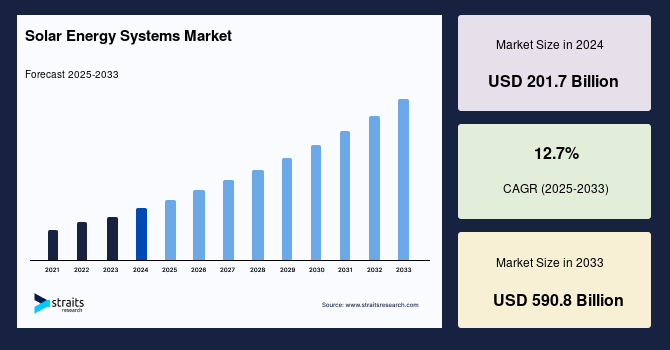The global solar energy systems market size was valued at USD 201.7 billion in 2024 and is projected to grow from USD 220.9 billion in 2025 to reach USD 590.8 billion by 2033, exhibiting a CAGR of 12.7% during the forecast period (2025-2033).
Driving Forces Behind Market Growth
Several factors propel the expanding solar energy systems market. At the core, ever-improving photovoltaic (PV) technologies drive efficiency gains, making solar power more economically attractive. Governments across the globe implement incentives such as tax breaks and subsidy programs to promote solar installations in residential, commercial, and industrial sectors. The urgent need to mitigate carbon emissions also motivates investments in renewable power, aligning with global sustainability objectives.
Increasing public awareness of the environmental benefits and cost savings associated with solar energy fosters higher demand. Innovations like Building Integrated Photovoltaics (BIPV), which seamlessly integrate solar panels into building materials, are transforming the power generation landscape by combining aesthetics with functionality. Additionally, the emergence of floating solar farms on water bodies represents novel deployment methods expanding available installation spaces beyond traditional rooftops.
Technological Advancements Shaping the Market
Photovoltaics remain the central technology in solar energy systems, converting sunlight directly into electricity through the photovoltaic effect. New developments are advancing solar cell efficiency beyond traditional limits. For example, perovskite solar cells have demonstrated efficiency exceeding 30%, surpassing conventional silicon panels. Tandem solar cells developed by technology leaders combine perovskite and silicon layers, significantly boosting power conversion capabilities.
Thin-film solar technologies utilizing materials such as copper indium gallium selenide (CIGS) and cadmium telluride (CdTe) introduce cost-efficient alternatives, suitable for large-scale installations. Companies specializing in these materials continue to scale production, reducing costs and increasing accessibility.
Microinverter technologies, such as those developed by leading companies, enhance system reliability by individually converting power from solar panels, improving energy capture even under shading or variable conditions. When paired with smart battery storage solutions, these systems offer greater energy independence and grid resilience.
Market Segmentation and Key Players
The solar energy systems market segments into major categories by type, product, and end-user. Solar Photovoltaics (PV) dominate the market segment due to their broad applicability and continual efficiency improvements. Concentrated Solar Power (CSP) holds a smaller share but remains relevant for utility-scale power generation.
By product, the residential sector leads market share, benefiting from growing homeowner adoption supported by government subsidies and increased affordability. Commercial and industrial sectors follow closely, incorporating solar systems to reduce operational costs and fulfill corporate sustainability goals.
Prominent industry players focus on innovation and strategic collaborations to strengthen their market presence. Notable companies manufacture specialized components such as solar panels, inverters, and energy storage units. Their investments in research and development aim to reduce costs and enhance the performance of solar energy systems.
Regional Outlook
The Asia Pacific region stands out as the largest and fastest-growing market. China, India, and Southeast Asian countries actively adopt renewable energy policies with incentives that accelerate solar installations. The region’s vast population and industrial growth further drive demand for clean energy alternatives.
North America also displays significant growth, led by the United States and Canada. Vigorous government support, including federal solar tax credits and rebate programs, combined with innovative companies spearheading technological advancements, propels market penetration. European countries continue to invest in solar energy to meet aggressive carbon neutrality targets.
Emerging markets in Latin America, the Middle East, and Africa offer substantial growth opportunities, powered by abundant sunlight and expanding renewable energy initiatives.
Challenges and Market Dynamics
Despite the robust growth outlook, the solar energy systems market faces integration challenges. The intermittent nature of solar power requires advanced forecasting and energy management to maintain grid stability. Large-scale solar plants often exist in remote locations, necessitating costly transmission infrastructure upgrades.
Regulatory complexities and the need for continuous technological innovation demand ongoing investments. However, the benefits of reduced greenhouse gas emissions, energy security, and long-term cost savings outweigh these hurdles.
Future Trends and Innovations
The future of solar energy systems is shaped by the convergence of technology and sustainability priorities. Smart grids integrating rooftop solar PV with traditional power networks improve efficiency and flexibility. The development of bifacial solar panels capturing sunlight from both sides increases energy yields.
Emerging research in perovskite cell scalability and durability could revolutionize solar panel manufacturing, making solar energy even more accessible and affordable. Additionally, energy storage advancements enhance the reliability of solar power by managing supply variability.
Government policies worldwide are expected to continuously incentivize solar adoption, further propelling market expansion. Public and private sector collaborations focused on green energy transition underline the strategic importance of solar energy systems in global energy portfolios.



















